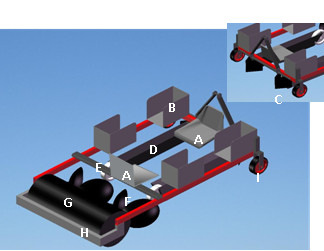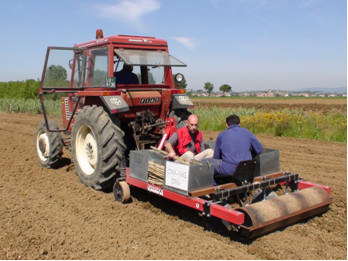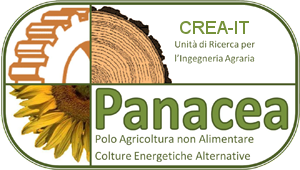Several research programs have identified those that are the most suitable crops to be used in various agro-energy chain. Among these, the giant reed (Arundo donax L.) is particularly interesting for many reasons: high amount of biomass production, limited demand for crop inputs, high resistance to water stress, the not complex collection, reduced moisture content at harvest and a high calorific value.
The Arundo donax is a perennial herbaceous species native of East Asia and subsequently spread throughout the Mediterranean basin due to a high degree of adaptability to different ecological conditions. Under optimum conditions of growth can have up to 100 t/ha of fresh matter and, as a rule, in the growing areas of southern Europe, you can get an average dry matter production of 30 t/ha, with peaks of 40 t/ha.
The main weakness of this crop is definitely related to its reproduction/propagation. The reproductive systems used for its cultivation are: small micro-propagated plants; rooted cuttings; rhizome cuttings; and stem parts planted along the row.
 Based on national and international studies, more focus on the roots of the rhizomes/rootstocks rather than cane culms was highlighted. However, the cost is still too high for micro-propagated plants or cuttings to rhizome due to the high density of the planting (8,000-10,000 p/ha). To date, the best solution for a reproductive system that guarantees the success of planting at a sustainable cost is not yet clear. The cane culms can be a good alternative, as they are easily available at a reduced cost. It is important to understand the validity of such a reproduction technique; this requires further experimentation.
Based on national and international studies, more focus on the roots of the rhizomes/rootstocks rather than cane culms was highlighted. However, the cost is still too high for micro-propagated plants or cuttings to rhizome due to the high density of the planting (8,000-10,000 p/ha). To date, the best solution for a reproductive system that guarantees the success of planting at a sustainable cost is not yet clear. The cane culms can be a good alternative, as they are easily available at a reduced cost. It is important to understand the validity of such a reproduction technique; this requires further experimentation.
 In order to make it easier, as well as to develop big dimensions planting with reduced costs, both agronomic researchers and the partners of the SUSCACE Project (whom these experimental tests are referred to), Panacea group designed and charged the construction of a prototype for cane culm transplantation to the Spapperi S.r.l. Company. This work is also aimed at evaluating, in a experimental way, the mechanical choices necessary to develop the machine, and to see if this reproductive system could be the best one. According to this system, cane parts measuring 1.1 – 1.2 m in length, were laid on two rows, 0.70 m spaced, into a furrow 200 – 250 m deep. Transplanting trials were conducted in various sites in Sardinia, Umbria, Emilia Romagna and Tuscany. The prototype (Fig. 1), a towed machine, was attached to a tractor at the 3 rear points. The operators sat on two seats (a), one opposite of the other. They were provided with a footboard. They manually introduced the stem pieces, which were allocated in the two lateral boxes (in shaped sheet) (b) that were positioned at a particular length and distance from the operators, enough so that effort was reduced during material sampling. The furrows were opened up to 200 – 250 mm depth by two ploughs, V shaped (c), which were positioned close to the operators. Two metal structures avoided the soil entering into the furrow during the operation of the position of the stem (d). To keep the cane at the bottom of the furrow, two idle wheels (e), which were particularly useful in a non-linear cane condition, were installed.
In order to make it easier, as well as to develop big dimensions planting with reduced costs, both agronomic researchers and the partners of the SUSCACE Project (whom these experimental tests are referred to), Panacea group designed and charged the construction of a prototype for cane culm transplantation to the Spapperi S.r.l. Company. This work is also aimed at evaluating, in a experimental way, the mechanical choices necessary to develop the machine, and to see if this reproductive system could be the best one. According to this system, cane parts measuring 1.1 – 1.2 m in length, were laid on two rows, 0.70 m spaced, into a furrow 200 – 250 m deep. Transplanting trials were conducted in various sites in Sardinia, Umbria, Emilia Romagna and Tuscany. The prototype (Fig. 1), a towed machine, was attached to a tractor at the 3 rear points. The operators sat on two seats (a), one opposite of the other. They were provided with a footboard. They manually introduced the stem pieces, which were allocated in the two lateral boxes (in shaped sheet) (b) that were positioned at a particular length and distance from the operators, enough so that effort was reduced during material sampling. The furrows were opened up to 200 – 250 mm depth by two ploughs, V shaped (c), which were positioned close to the operators. Two metal structures avoided the soil entering into the furrow during the operation of the position of the stem (d). To keep the cane at the bottom of the furrow, two idle wheels (e), which were particularly useful in a non-linear cane condition, were installed.
The furrows were closed by a couple of dual ridging discs that served to cover furrow (f). Finally, the prototype was equipped with a compaction roller (g), which had the same width of the machine lateral side play, and whose performance was adjusted to improve the contact between the soil and the planted stems. In order to avoid soil from excessively adhering to the roller, a scratch-roller was mounted behind the roller itself (h). The position and working height of member-machine was adjusted to guarantee its maximum adaptability to different features of the fields. The working height was directly adjusted from the tractors hydraulic lift as well as from the two idle wheels (adjustable in height) (i).
The transplantation tests was performed at various locations between Sardinia, Umbria, Emilia Romagna and Tuscany. The most recent experience was conducted in May 2009 at the Center for testing and transfer of innovation of Cesa (ARSIA), in Marciano della Chiana (Ar) on a 600 m2 plot. placing culms cane from local ecotypes. The experimental protocol followed included several thesis, burying portions basal, intermediate and apex of the stems and buds with different density per linear meter. Planting giant reed culms from local landraces, a few days before being surveyed from an adjoining plant, were divided into three parts, which were 1.1 m in length.
The experimental design followed included several theses, was inground portions basal, intermediate and apex of the stems with different buds density per linear meter.



